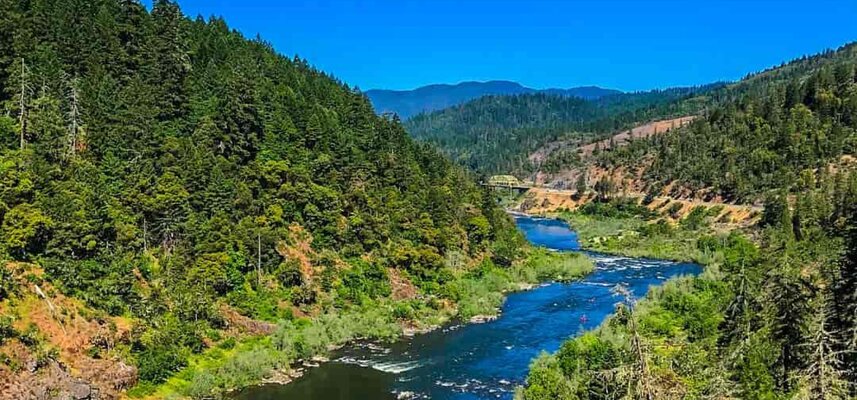Bank fishing along the Rogue River, a gem in the heart of southern Oregon, is an angling experience that combines scenic beauty, abundant wildlife, and a diverse fishery. The Rogue River stretches over 200 miles from the Cascade Range to the Pacific Ocean, offering a variety of fishing environments, from its upper reaches near Crater Lake National Park to the rugged canyons and finally to its estuary near Gold Beach. This essay explores the nuances of bank fishing on the Rogue River, including the species available, prime locations, strategies for success, and the importance of conservation practices to ensure the sustainability of this magnificent river's ecosystem.

The Allure of the Rogue River
The Rogue River is renowned for its rich biodiversity and the variety of angling opportunities it presents. Its clear, cold waters are home to a plethora of fish species, making it a favored destination for anglers seeking both the tranquility of nature and the thrill of the catch. The river's dynamic flow, diverse habitats, and scenic beauty add to its appeal, drawing visitors from across the globe.
Target Species for Bank Anglers
Bank fishing the Rogue River offers the chance to target a wide range of species, with tactics and timing varying by location and season:
- Salmon: The Rogue is famous for its runs of Chinook (King) salmon in the spring and fall, as well as Coho (Silver) salmon in the fall. These powerful fish offer a challenging and rewarding experience for bank anglers.
- Steelhead: Both summer and winter steelhead runs attract anglers to the Rogue. These migratory rainbow trout are known for their acrobatics and fighting prowess.
- Trout: The upper sections of the Rogue River provide excellent opportunities for catching rainbow and cutthroat trout, especially appealing for fly fishermen.
- Bass and Panfish: In the lower, warmer sections of the river, smallmouth bass and various panfish species can be targeted, offering a fun and accessible option for anglers of all skill levels.
Prime Locations for Bank Fishing
The Rogue River's diverse landscape means that bank fishing spots are plentiful and varied. Some key areas include:
- Upper Rogue: Near Shady Cove and the Hatchery, where access is facilitated by parks and public lands. This area is excellent for trout and early-season steelhead.
- Middle Rogue: Grants Pass to Gold Hill features accessible banks and riffles that are ideal for salmon and steelhead, especially during migration periods.
- Lower Rogue: Near Agness and the estuary, where the river widens, and salmon and steelhead congregate before entering the ocean or returning upstream to spawn.
Strategies for Success
Success in bank fishing the Rogue River involves understanding the river's conditions, fish behavior, and adapting techniques accordingly:
- Know the Seasons: Timing is everything. Salmon fishing peaks in spring and fall, while steelhead can be targeted in summer and winter. Trout are more abundant in the upper river during the warmer months.
- Gear and Bait: Use gear appropriate for the species you’re targeting. Salmon and steelhead anglers often use heavier tackle, while trout fishing requires lighter gear. Bait choices range from worms and salmon eggs for trout to larger plugs and spinners for salmon and steelhead.
- Reading the Water: Look for spots where fish are likely to hold, such as behind boulders, in deep pools, or at the tail end of riffles. Casting to these areas increases your chances of a bite.
- Stealth and Patience: Approach the river quietly to avoid spooking fish. Patience is key, as is persistence in changing tactics if something isn’t working.
Conservation and Ethical Angling
The Rogue River's ecosystem is fragile, and its health is crucial for the species that inhabit it. Anglers play a vital role in conservation efforts through ethical fishing practices:
- Catch and Release: Practice catch and release, especially with native species, to help maintain population levels. Use barbless hooks and handle fish with care.
- Respect Regulations: Follow all fishing regulations regarding seasons, bag limits, and gear restrictions to support sustainable fisheries management.
- Leave No Trace: Keep the riverbanks clean by packing out all trash, including fishing line and bait containers, to protect wildlife and preserve the river's natural beauty.
- Habitat Restoration: Participate in or support local habitat restoration projects to improve the health of the river ecosystem.
Conclusion
Bank fishing on the Rogue River offers an unparalleled opportunity to connect with nature and pursue a diverse range of fish species in one of Oregon’s most scenic waterways. By understanding the river’s patterns, respecting its inhabitants, and adhering to conservation principles, anglers can enjoy the thrill of the catch while ensuring that the Rogue River remains a vibrant and productive fishery for future generations. Whether seeking the solitude of a quiet trout stream or the excitement of landing a mighty Chinook salmon, the Rogue River’s banks provide a perfect stage for the angling adventure of a lifetime.
